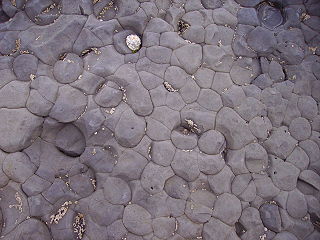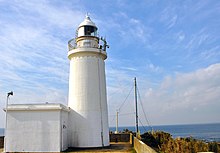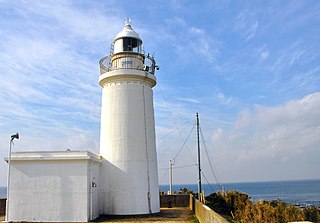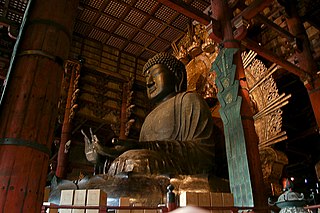
Tokyo Bay is a bay located in the southern Kantō region of Japan, and spans the coasts of Tokyo, Kanagawa Prefecture, and Chiba Prefecture. Tokyo Bay is connected to the Pacific Ocean by the Uraga Channel. Its old name was Edo Bay. The Tokyo Bay region is both the most populous and largest industrialized area in Japan.

Katsuura is a city located in Chiba Prefecture, Japan.

Kamogawa is a city located in Chiba Prefecture, Japan.

The Uraga Channel is a waterway connecting Tokyo Bay to the Sagami Gulf. It is an important channel for ships headed from Tokyo, Yokohama, and Chiba to the Pacific Ocean and beyond.

The Bōsō Peninsula is a peninsula that encompasses the entirety of Chiba Prefecture on Honshu, the largest island of Japan. It forms the eastern edge of Tokyo Bay, separating it from the Pacific Ocean. The peninsula covers approximately 5,034 square kilometres (1,944 sq mi).

Awa District is a district located in Chiba Prefecture, Japan. As of August 2010, the district had an estimated population of 8,992 and a density of 198 persons per km². Its total area was 45.16 square kilometres (17.44 sq mi). Awa District at present consists only of the town of Kyonan

Mount Nokogiri literally "saw mountain" is a low mountain on the Bōsō Peninsula on Honshu, Japan. It lies on the southern border of the city of Futtsu and the town Kyonan in Awa District in Chiba Prefecture.

Cape Myōgane is a cape located on the border of Futtsu and Kyonan, Chiba, Japan, where Mount Nokogiri on its western end precipitously falls into the Uraga Channel to Tokyo Bay.
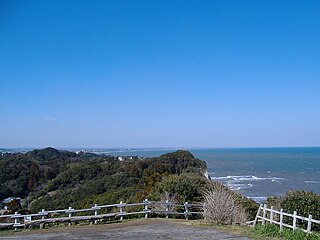
Cape Taitō is a cape on the Pacific Ocean, in the city of Isumi, Chiba Prefecture, Japan. The cape is located at the very southern point of Kujūkuri Beach on the island of Honshu.

Cape Hachiman is a cape on the Pacific Ocean, in the city of Katsuura, in the southeast area of Chiba Prefecture, Japan. There are two Cape Hachimans located in close proximity to one another: Cape Hachiman in Katsuura, and Cape Hachiman a few kilometers to the north in Isumi City. The cape is named after Hachiman, a mythological Japanese god of archery and war.
The Bōsō Chiran-Ki (房総治乱記), or "Chronicle of Bōsō at War and Peace", is a minor Japanese medieval text of unknown authorship that chronicles events of the southern part of Kazusa Province of the Bōsō Peninsula in present-day Chiba Prefecture in the late 16th and early 17th centuries.

The Bōsō Hill Range is a mountain range on the Bōsō Peninsula of Chiba Prefecture, Japan. The highest point in the Bōsō Mountain Range is at Mount Atago, with an altitude of 408.2 m (1,339 ft). The hill range runs from roughly in a line from Mobara or Ōamishirasato to Kisarazu, but is not formally defined. It is an important part of the Minami Bōsō Quasi-National Park.

Mount Tomi is a mountain on the border of the city of Minamibōsō, in southern Chiba Prefecture. The mountain is formed by two peaks. The north, called Konpira Peak, is 349.5 m (1,147 ft), and the south, called Kannon Peak, is 342 m (1,122 ft). Mount Tomi is one of the mountains of the Mineoka Mountain District of the Bōsō Hill Range.

Mineoka Mountain District is an area in the Bōsō Hill Range in the southern part of Chiba Prefecture. The Mineoka Mountain District runs along an east-west line across the southern part of the Bōsō Peninsula from the southern bank of the Kamo River in Kamogawa, facing the Pacific Ocean, to the Sakuma District of Kyonan, facing Tokyo Bay. The highest peak in the mountain district is at Mount Atago 408.2 m (1,339 ft) Mineoka is formed from two kanji characters: the first "嶺", meaning 'peak' or 'summit' and the second "岡" meaning 'mount' or 'hill.'

The Koito River is a river in Futtsu and Kimitsu, Chiba Prefecture, Japan. The river is 82 kilometers (51 mi) in length and has a drainage area of 148.7 square kilometers (57.4 sq mi). The Koito is the third-longest river in Chiba Prefecture, and under the Rivers Act of 1906 the Koito is designated as a Class 2 River. The name of the river in Japanese is a combination of two kanji characters, the first meaning “little”, and the second meaning “thread”.

Nihon-ji is a Buddhist temple in the city of Kyonan, Chiba Prefecture, Japan. The temple is located on the slopes of Mount Nokogiri and is known for its Nihon-ji Daibutsu. Nihon-ji was established as a Hossō sect temple, was transferred to the Tendai sect, and is now a Sōtō Zen temple. Since its founding the temple has fallen into ruin and been revived numerous times.

Mount Dōgo, is a volcanic mountain located on the border of Nichinan, Tottori Prefecture and Shōbara, Hiroshima Prefecture. The mountain has an elevation of 1,268 m (4,160 ft). The name of Mount Dōgo in Japanese is formed from two kanji. The first, 道, means "road" and the second, 後, in this context means "behind" or "to the rear". Due to its scenery mountain is known as the "Queen of the Chūgoku Mountains."

Mount Sentsū, also known in English as Sentsūzan, is a mountain located on the border of Nichinan, Tottori Prefecture and Okuizumo, Shimane Prefecture. Mount Sentsū has an elevation of 1,142 m (3,747 ft) and is one of the highest peaks in the Chūgoku Mountain Range and part of the Hiba-Dogo-Taishaku Quasi-National Park. Mount Sentsū was historically on the border of the ancient provinces of Hōki Province and Izumo Province. The base of Mount Sentsū is primarily composed of granite. This granite is a rich source of iron sand, and the mountain was historically known as a source for this material.

Byōbugaura is an inlet on the northeast coast of Chiba Prefecture that ranges from Cape Inubō in Chōshi to Cape Gyōbumi in Asahi. Byōbugaura is an important part of the coastal area in Chiba Prefecture, as it connects the northern point of the Pacific Ocean coast at Chōshi to Kujūkuri Beach, which covers a large portion of the western side of the prefecture. The name of the inlet is formed from the word "byōbu", the Japanese-style folding screen, and "ura", meaning an inlet. Byōbugaura resembles the White Cliffs of Dover on the English Channel. For this reason the inlet is sometimes called Tōyō no Dōbā (東洋のドーバー), or "Dover of the East". Byōbugaura is known for its long history of marine erosion.






